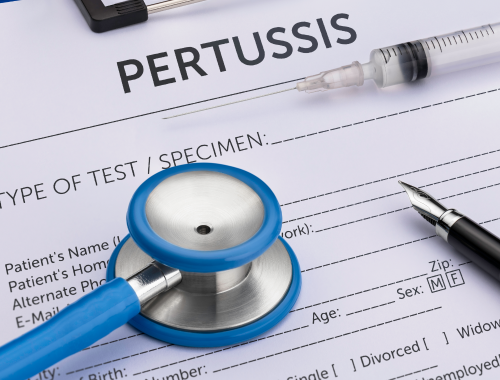Pertussis, also known as whooping cough, is a serious respiratory infection caused by a bacterium called Bordetella pertussis. Tuberculosis (TB) is a complicated respiratory disease caused by Mycobacterium tuberculosis. Mycobacterium primarily affects the lung tissue, but tuberculosis can also affect a variety of organs, thus this disease is multisystemic.

What is pertussis?
Definition:
Pertussis, also called whooping cough, is a highly transmissible respiratory infection caused by Bordetella pertussis.
Causative agent:
Pertussis is caused by a gram-negative bacterium that is Bordetella pertussis.
Symptoms:
The symptoms of pertussis include coryza, stuffed nose, sneezing, nasal congestion, fever, serious hacking cough, vomiting, epiphora, flushed or cyanosed face, lethargy, and a high-pitched whoop sound following the cough.
Diagnosis:
Whooping cough is diagnosed on physical examination, nasopharyngeal swabs, and culture and blood tests. Chest X-ray is an important investigation as well.
Treatment:
Strong antibiotics, particularly macrolides like erythromycin are used to prevent and treat whooping cough. Supportive treatment is particularly vital in settling down the symptoms. It includes drinking a good amount of fluids, eating smaller meals, using humidifiers, steam inhalation, covering the cough, and frequent hand washing.
Complications:
The complications of uncontrolled pertussis are bruised, broken ribs, subconjunctival hemorrhage or bloodshot eyes, pneumonia, apnea, seizures, abdominal hernias, and cerebral tissue damage.
Prevention:
The Pertussis vaccine is widely available since the late 20th century. It is given alongside diphtheria and tetanus immunization.

What is tuberculosis?
Definition:
Tuberculosis is a serious respiratory disease caused by Mycobacterium tuberculosis. Mycobacterium primarily affects the lung tissue, but tuberculosis can also affect a variety of organs.
Causative agent:
Mycobacterium tuberculosis causes tuberculosis.
Symptoms:
Latent TB is asymptomatic. Active tuberculosis presents with weight loss, long-term productive cough, blood in cough, night sweats, low-grade fever, difficulty in breathing, chills, and loss of appetite.
Diagnosis:
Initial investigations for detecting TB include chest X-ray and blood tests. Definitive diagnostic tests include sputum culture, bronchoalveolar lavage, and rarely gastric lavage.
Treatment:
A strict 6-month regimen of anti-tuberculous drugs has to be complied with for TB eradication. These drugs include rifampin, isoniazid, pyrazinamide, and ethambutol.
Complications:
The complications of TB include arthritis, back pain, stiffness, meningitis, miliary TB, heart disorders, lymphadenitis, and intestinal TB.
Difference between Pertussis and Tuberculosis
Definition:
Pertussis, also known as whooping cough, is a serious respiratory infection caused by a bacterium called Bordetella pertussis. Tuberculosis is a serious respiratory disease caused by Mycobacterium tuberculosis. Mycobacterium primarily affects the lung tissue, but tuberculosis can also affect a variety of organs.
Symptoms:
The symptoms of pertussis include coryza, stuffed nose, sneezing, nasal congestion, fever, serious hacking cough, vomiting, epiphora, flushed or cyanosed face, lethargy, and a high-pitched whoop sound following the cough. On the other hand, active tuberculosis presents with weight loss, long-term productive cough, blood in cough, night sweats, low-grade fever, difficulty in breathing, chills, and loss of appetite.
Diagnosis:
Whooping cough is diagnosed on physical examination, nasopharyngeal swabs, and culture and blood tests. Chest X-ray is an important investigation as well. Diagnostic tests for TB include sputum culture, bronchoalveolar lavage, and rarely gastric lavage.
Treatment:
Macrolides like erythromycin are used to prevent and treat whooping cough. Drinking a good amount of fluids, eating smaller meals, using humidifiers, steam inhalation, covering the cough and frequent hand washing also helps in settling down the symptoms. TB is treated with anti-tuberculous drugs like rifampin, isoniazid, pyrazinamide, and ethambutol.
Complications:
The complications of uncontrolled pertussis are bruised, broken ribs, subconjunctival hemorrhage or bloodshot eyes, pneumonia, apnea, seizures, abdominal hernias, and cerebral tissue damage. The complications of TB include arthritis, back pain, stiffness, meningitis, miliary TB, heart disorders, lymphadenitis, and intestinal TB.
Table of differences between Pertussis and tuberculosis

FAQs
What causes TB and pertussis?
TB is caused by Mycobacterium tuberculosis whereas pertussis is caused by Bordetella pertussis.
What is the difference between whooping cough and pertussis?
Both are the same.
How are tuberculosis and diphtheria different?
Pertussis, also known as whooping cough, is a serious respiratory infection caused by a bacterium called Bordetella pertussis. Tuberculosis (TB) is a serious respiratory disease caused by Mycobacterium tuberculosis. Pertussis mainly affects the respiratory system, whereas TB affects many organs.
What are the 3 types of tuberculosis?
Active TB, latent TB, and miliary TB.
What is whooping cough called now?
Pertussis.
What can be mistaken for pertussis?
Bronchitis and upper respiratory tract infections.
- Differences Between Reptiles and Amphibians - May 17, 2024
- Difference Between Ophthalmology and Optometry - May 15, 2024
- Difference Between Fear and Anxiety - April 2, 2024

